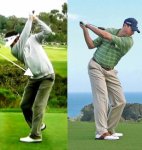bobmac
Major Champion
It's a great piece of advice and it's in all the books so it must be right.
But is it implemented correctly?
The golfer has a great backswing up to the top and thinks, 'start the downswing from the ground up'. So the lower half starts first, they think the upper half goes next, finally the arms and club.
What often happens though is the lower half starts the downswing but the shoulders follow at the same time.
Try this at home/office/train platform......
Pretend you have a club in your hand and swing to the top then stop.
Without moving anything else, slowly turn your hips. Where do your hands go? Outside the line.
Now try the same exercise again but this time as your start turning your lower half, keep your shoulders pointing to the right as long as you can (for right handers)
Now you will feel how the lower half goes first then the top half a fraction later.
I think the advice 'Start the downswing from the ground up' is good but it's poor implementation is the cause of many a golfers slicing woes.
Food for thought i hope
But is it implemented correctly?
The golfer has a great backswing up to the top and thinks, 'start the downswing from the ground up'. So the lower half starts first, they think the upper half goes next, finally the arms and club.
What often happens though is the lower half starts the downswing but the shoulders follow at the same time.
Try this at home/office/train platform......
Pretend you have a club in your hand and swing to the top then stop.
Without moving anything else, slowly turn your hips. Where do your hands go? Outside the line.
Now try the same exercise again but this time as your start turning your lower half, keep your shoulders pointing to the right as long as you can (for right handers)
Now you will feel how the lower half goes first then the top half a fraction later.
I think the advice 'Start the downswing from the ground up' is good but it's poor implementation is the cause of many a golfers slicing woes.
Food for thought i hope


